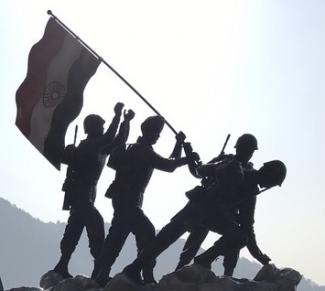Falling Esprit de Corps: Fragging and Suicides in Indian Army
While India is known for its disciplined armed forces, numbers of stress-related deaths in the form of suicide and fragging have been increasing in recent years, especially in troubled states of Jammu and Kashmir (J&K) and Northeast India. Apart from tackling terrorism, escalation of fragging and suicides in such sensitive regions provide additional threats to national security. It also affects the morale of young aspirants and distracts them from pursuing it as a career option.
The word ‘fragging’ or ‘frag incident’ was a slang used by American troops during the Vietnam War for killing, wounding or deliberate maiming of an unpopular fellow soldier or a superior. The term first came to the public attention in 1971 when a trial was held against African American soldier Billy Dean Smith who was accused of executing two white officers. Similarly, in India, 11 soldiers have also been sentenced to death since 1984 against fratricidal crime, and so far, in this year, India witnessed at least six such incidents against 23 in 2006. Most of the incidents have commonly happened in J&K than NE, and over the last five years, it has been recorded that 100 soldiers have died of its fratricidal shoot-out in J&K.
Even as the Indian Army is trying to cope with this dangerous trend, one soldier identified as Mohan Chand Munda, from the Eight Bihar Regiment killed his company commander, Major P Alexander, on July 23 at a forward post in the Gurez of J&K. Further investigation has revealed that the soldier was outraged over denial of leave by the officer. Refusing leaves and using abusive or derogatory language by a superior are nettlesome matters that lead a soldier to attack his superior or a colleague. One of the latest studies against fragging by the Defence Institute of Psychological Research (DIPR) has stated that troops deployed in counter-insurgency operations in J&K and NE perceived humiliations and harassment at the hand of their seniors, moreover professional and familial factors have also been forced them to take such extreme steps. Prolonged inter-personal hostility and underlying anger might also be a cause to push the soldier over the brink against another.
However, a report recently submitted by military psychologists to the Defense Ministry has attributed that such incidents were linked with various factors, including poor morale, improper ways of maintaining discipline, senseless demands by superiors, monotonous duties and class conflict. Fragging can also be connected with the poor mental health of the troops, and hence, over the last three years, the Indian army has recorded a 45 per cent shoot in the number of troops being discharged due to such disorder.
The soldier dies not only from enemies’ bullets but also from his own weapon. Besides fragging, suicides are quite common in the forces, and the number has been increasing considerably at the rate of 100 cases every year. One more soldier Sulaiman Khan committed suicide at the 16-corps battle school in Doda district of J & K on August 13. Since January 2006, over 140 stressful soldiers have committed suicide. For the first time in Indian military history, a women Army officer, Lt. Sushmita Chakravarty, of 5071 ASC battalion, shot herself on June 16, 2006, in Udhampur, the headquarters of the Northern Command. She was commissioned 10 months before she died and found her job regrettable as she was displeased with the job responsible for catering and organizing late-night parties. Again that year, on December 1, Lt. Col. Pankaj Jha from 15 Rashtriya Rifles killed himself in Udhampur.
Causative factors of suicide soldiers are similar to that of fragging. Issues like non-grant of timely leave, zero-error syndrome, workload, lack of adequate rest, possession of disgraceful disease like HIV/AIDS, and other personal disturbances in their family such as property disputes, financial problems, and marital crisis are the common impinging elements that lead a soldier to kill himself.
To secure from these stress-related deaths, the top defence establishment has recommended having amicable relations among the soldiers, helping with their domestic dilemmas, increasing salary perks, providing good weapons and equipment, improving the troops' selection and training patterns and using religious teachers as counsellors. The present government recently informed the Parliament that necessary measures are being taken to manage stress within the forces that included establishing a toll-free helpline number, rotation of units to minimize exposure to stress, better man-management, and prompt attendance of grievances unit-level, and liberalization of leave policy. Late last year, Army had announced that it would hire around 400 psychiatrists to cut stress within its units.
Fragging and suicides not only deprecate the forces but also help to reduce their number. Already Army has a deficiency in its size, it has a ‘sanctioned strength’ of 46 615 officers, but presently 11, 238 short and in 2006 alone, 811 officers had applied for ‘premature retirement’. Although most young and middle-rung officers are attracted by the upcoming Business Process Outsourcing (BPO) industries and desire to leave their jobs due to poor salaries, the ugly trend of fragging and suicides has also created a phobia of sorts in the mind of young aspirants to detach from the ‘institution’.
